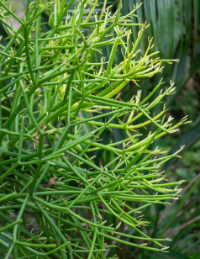Pencil Cactus
by Chris Stuhlsatz

The pencil cactus, also known as Euphorbia tirucalli, is a unique and distinctive succulent plant that is not a true cactus, despite its common name. It belongs to the Euphorbia genus and is native to Africa, particularly in regions like Madagascar. The plant is often referred to as a "pencil cactus" due to its thin, pencil-like, green stems that grow upright, resembling the shape of a pencil.
Key features of the pencil cactus include:
- Pencil-Like Stems: The most noticeable characteristic of the pencil cactus is its slender, cylindrical stems, which can reach great heights. These stems are typically green, but they can sometimes take on a reddish or purplish hue, especially when exposed to direct sunlight.
- Leaves: The pencil cactus lacks traditional leaves. Instead, small, inconspicuous leaves are present along the stems, usually at the tips. These leaves are short-lived and quickly fall off.
- Toxic Sap: One of the notable traits of the pencil cactus is its milky white latex-like sap, which can be toxic and irritating to the skin and eyes. Care should be taken when handling this plant, and it should be kept away from children and pets.
- Easy to Care for: Pencil cacti are relatively low-maintenance plants and can thrive in a variety of conditions. They prefer bright, indirect sunlight but can tolerate some direct sun. They are drought-tolerant and require well-draining soil. Water sparingly and allow the soil to dry out between waterings.
- Growth: Pencil cacti can grow quite tall, often reaching heights of 6 to 15 feet (1.8 to 4.6 meters) or more when grown as a houseplant. Regular pruning can help control their size and maintain their shape.
- Indoor and Outdoor Use: While the pencil cactus is commonly grown as a houseplant, it can also be planted in gardens in warmer climates, provided that the climate is not too cold or frosty.
- Caution: As mentioned earlier, the sap of the pencil cactus is toxic, so it should be kept out of reach of pets and children. When pruning or propagating the plant, wearing gloves and taking care to avoid contact with the sap is advisable.
Overall, the pencil cactus is a unique and visually striking plant that can add a touch of the exotic to your indoor or outdoor garden, but it should be handled with care due to its toxic sap.

Have questions? Contact our office where our Horticulture Extension Agent will assist you with questions.
Phone: (316) 321-9660
Email: callae@ksu.edu